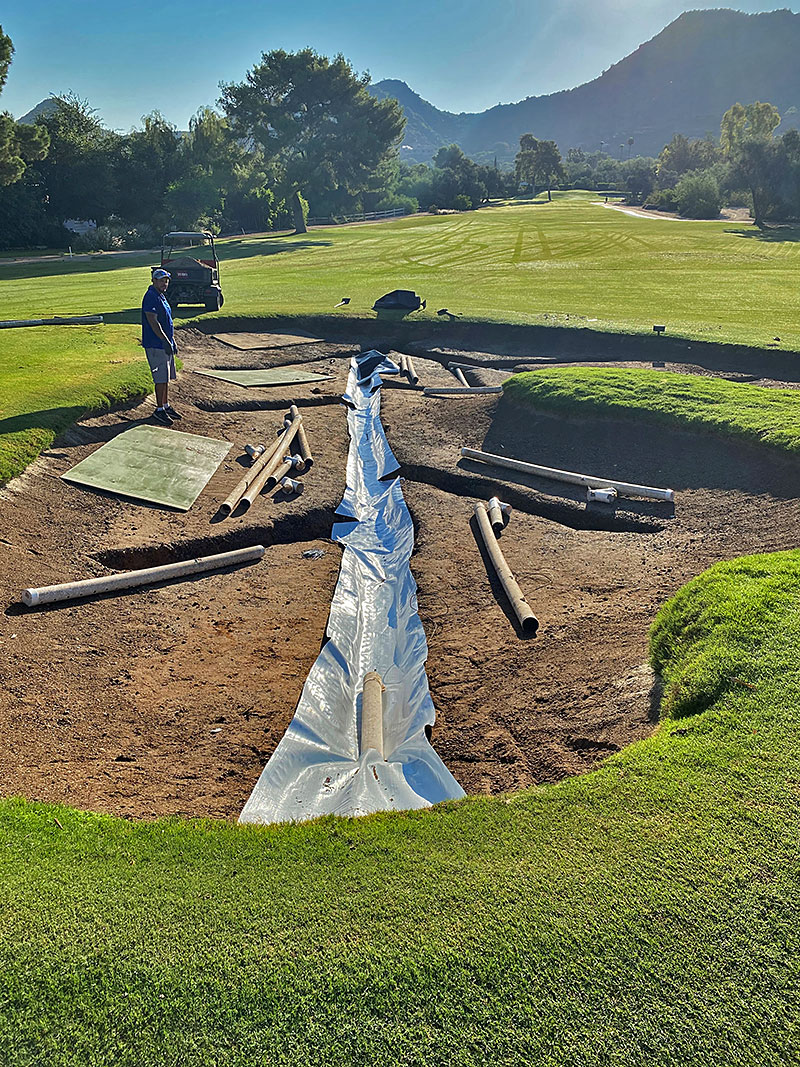Paradise in the Desert? It’s possible with Bunker Solution
A lot has changed in Rob Collins’ 30 years at Scottsdale’s famed Paradise Valley CC, but one thing has not: he still wakes up every day thinking about presenting the best golf course possible to his members.
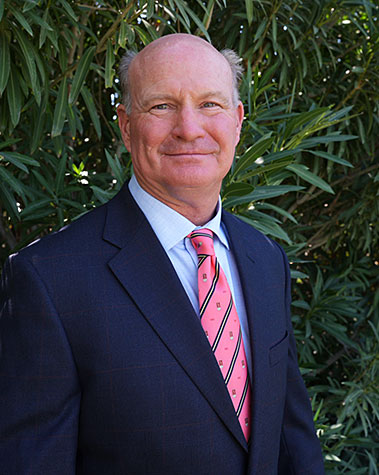
Collins, a legend of desert turf management and a recent inductee into the Arizona Golf Hall of Fame, started at the club in 1995 and struggled for years with bunkers designed in the 1950s and rebuilt by Keith Foster in the ‘90s. A major renovation by Crenshaw and Coore in 2014 included a big upgrade: modern hardscaped bunkers. “That was the state-of-the-art technology at the time,” says Collins.
Thanks to Bill and Ben, bunkers became shallower, easier to access and more playable. “The new design was a big hit, but the perched water table issue caused us to retain water and grow algae all summer,” says Collins. “That deteriorated the sand’s performance over time.”
Collins fought back with a strategy to clean the sand on a regular basis. “We’re pretty unique as one of just a handful of courses that cleans our bunker sand routinely. Every two years or so we’d put our sand through a ‘sand screw’ to pull fines and organic matter out the sand and then put it back into the bunkers. It’s obviously a very cheap alternative to buying sand but we had to do it a lot and that wasn’t optimal.”
A few years ago, Collins decided the time had come to consider easier ways to maintain sand quality. “We experimented with other hardened systems and found we could eliminate the algae build-up problem. But the catch was that the ‘concrete trench’ made me nervous. Imagine getting thin on bunker sand and hitting into that concrete leading edge? That didn’t seem like a good idea.”
But, a decade beforehand, the club had also installed a Bunker Solution liner by a very popular chipping green. It was the most used bunker on the golf course and got tons of use and abuse. “That Bunker Solution liner was in there, untouched, for like 12 years,” says Collins. “We constantly added bunker sand and kept having to take down the face but it consistently stayed dry and clean. We realized that exposing the sand directly to the drain tile was key. Knowing that bunker had been in place for a decade and the members had always liked the playability made all the difference.”
Simply put, Collins’ analysis suggested Bunker Solution was the right way to go. “I want what everybody wants: I want a solution.”
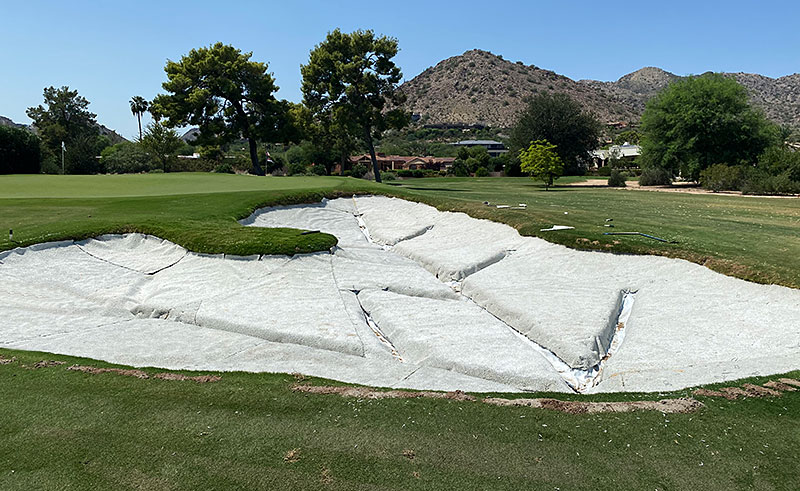
First, he had to make his case to the membership. “There’s a dialog that comes along with this. I understood their frustration with the greenside bunkers. Fortunately, we were able to explain and demonstrate how these changes would help to the members. And, as soon as you do one green complex with a technology like Bunker Solution, it’s an epiphany.”
The proof was in the playability “but I also explained that having free drainage through the sand into the drain tile is ultimately the key,” says Collins. “They wanted drier conditions, but they also needed to understand the physics of it all.”
Based on that, they began the conversion in 2022 with a three-year plan to do all the greenside bunkers with Bunker Solution. “We did the first 6 holes and then instantly decided to do the rest of them. It was that much better.”
Interestingly, they left the fairway hazards with the original construction. “We think the average golfer prefers a firm fairway bunker and we already had that. So, we left the original system with those moister conditions in place on fairways.”
Years ago, the club had purchased an Eagle Iron Works sand cleaning system that Collins believes is now 80+ years old but still working well. “During the renovation, we did screening and cleaning on about 1,000 tons of sand. We put it all through the sand screw and it was so clean it looked like it came right off the truck. It’s a really quick process. Essentially, we’re taking out the fines, algae growth and particulates and it really does look like brand new. We get clean sand for about $10 a ton.” Now, with Bunker Solution, they clean a lot less often.
The secret to his success is the Bunker Solution design along with consistent maintenance practices. “One of the things we do is to keep the same people on the task,” says Collins. “We’re fortunate to have some very experienced employees whose job is all about bunkers. They are our bunker gurus. It makes all the difference in the world because they’ve really taken ownership. They take a lot of pride in what they do and we’re lucky to have them.
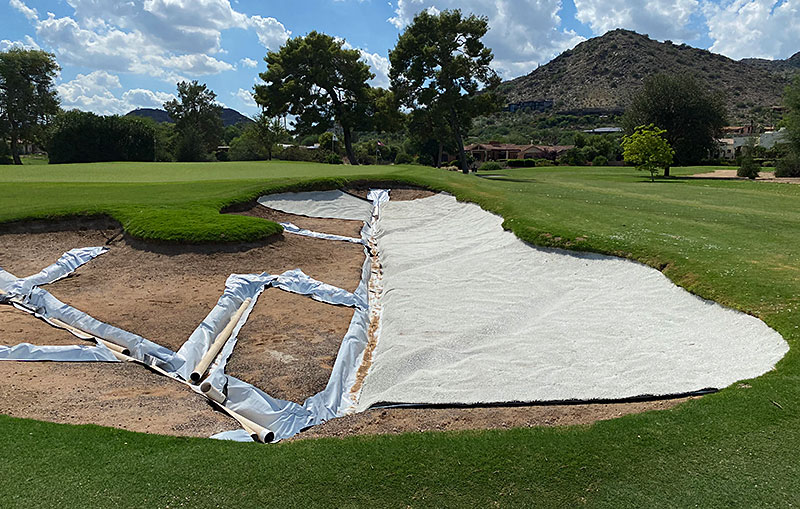
How do you describe the Bunker Solution technology to others?
“I call it white Astroturf. It has a nap. Our bunkers are mostly shallow, but a few are flashed. That condition – I call them the “Rice Krispie treat liner systems – often suggests a thicker sand profile. But you run the risk of fried egg lies and such. Honestly, with it being white Astroturf you can have just the thinnest layer of sand and maybe even a few fibers exposed. But they just kind of blend in and it doesn’t impact playability. Bunker Solution works great for us in that regard because we’re able to manage sand depth for playability instead of for safety. That’s a big difference.”
Why does he rely on mechanical rakes instead of hand-raking? “There’s kind of a stigma with mechanical raking but it’s the right choice for us. I honestly believe mechanical rakes produce more consistency in bunkers than hand-raking. If you have 4 – 6 crew members hand-raking and, even if you train them well, they still all do something a little differently and you’re going to have differences in depth of disturbance and other factors. But that mechanical rake doesn’t know the difference.”
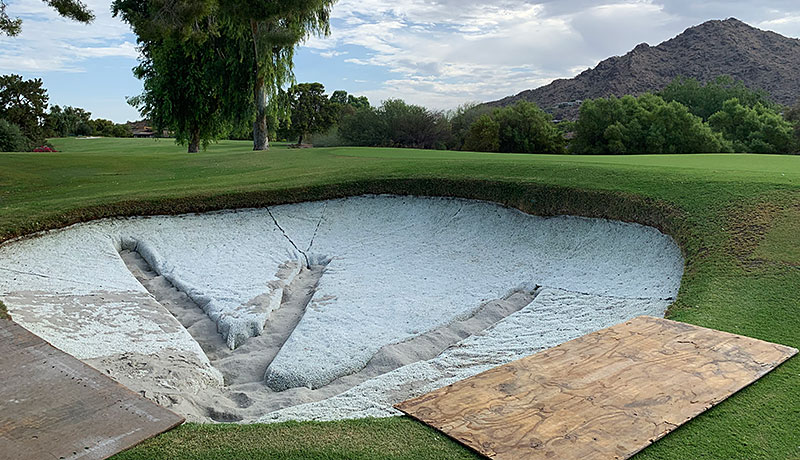
The secret is in the set-up. “You set the apparatus to specific depths – in our case we’re about 1.5” deep with a bolt turned upside down. We change out the worn parts frequently. So, in terms of playability, I think it’s more consistent than hand-raking but it’s hard to overcome the stigma of seeing that pattern out there from a mechanical rake. But when you couple that mechanical process with the Bunker Solution concept that produces uniform conditions in terms of wetness, to me that’s exactly what you want. The liner system is part and parcel of producing uniform sand conditions and a uniform product.”
The bottom line for Collins is that there’s room for Bunker Solution along with the hardened systems. “I take for granted that Bunker Solution is well understood but I know some people still confuse them with the old-school liners. They are light years apart. They are nothing alike. The fact that we’re using a mechanical rake right over the top and I know there’s times we touch the Bunker Solutions liner and we have zero problems with that. That’s all the proof we need.”
